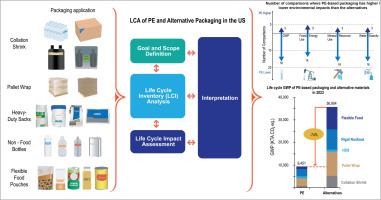聚乙烯包装和替代材料在美国:生命周期评估。
IF 8
1区 环境科学与生态学
Q1 ENVIRONMENTAL SCIENCES
引用次数: 0
摘要
在美国进行了一项全面的生命周期评估,以评估聚乙烯(PE)包装及其替代品(包括纸、玻璃、铝和钢)对环境的潜在影响。评估的重点是五个主要的包装应用:整理收缩薄膜,拉伸薄膜托盘包装,重型麻袋,非食品瓶和柔性食品袋。该研究根据以下环境影响类别对PE和替代包装材料进行了比较:全球变暖潜能值(GWP)、化石能源使用、矿产资源使用和水资源短缺。该研究整合了每种应用的销售量估计,检查了PE基材料的替代率和使用PE作为包装材料的GWP降低能力。研究结果表明,用PE代替其他包装材料可以使平均生命周期的全球变暖潜能值排放量减少约70%。这一显著的下降凸显了PE在美国包装解决方案中潜在的GWP效益。我们还详细分析了与PE及其替代品相关的潜在环境影响和权衡。从这项研究中获得的见解旨在帮助利益相关者和决策者做出明智的决定,在减轻环境影响与保持产品功能和实现可持续性目标之间取得平衡。本文章由计算机程序翻译,如有差异,请以英文原文为准。

Polyethylene packaging and alternative materials in the United States: A life cycle assessment
A comprehensive life cycle assessment was conducted to evaluate the potential environmental impacts of polyethylene (PE) packaging and its alternatives, including paper, glass, aluminum, and steel in the United States. The assessment focuses on five major packaging applications: collation shrink films, stretch films for pallet wraps, heavy-duty sacks, non-food bottles, and flexible food pouches. The study compares PE and the alternative packaging materials based on the following environmental impact categories: global warming potential (GWP), fossil energy use, mineral resource use, and water scarcity. The research integrates sales volume estimates for each application, examining the substitution ratios of PE-based materials and the GWP decrease capabilities of using PE as packaging material. The findings reveal that substituting PE for other packaging materials can lead to an average life cycle GWP emissions decrease of approximately 70 %. This significant decrease highlights the potential GWP benefits of PE in the context of packaging solutions in the United States. We also provide a detailed analysis of the potential environmental impacts and trade-offs associated with PE and its alternatives. The insights gained from this study are intended to assist stakeholders and policymakers in making informed decisions that balance environmental impact mitigation with maintaining product functionality and achieving sustainability objectives.
求助全文
通过发布文献求助,成功后即可免费获取论文全文。
去求助
来源期刊

Science of the Total Environment
环境科学-环境科学
CiteScore
17.60
自引率
10.20%
发文量
8726
审稿时长
2.4 months
期刊介绍:
The Science of the Total Environment is an international journal dedicated to scientific research on the environment and its interaction with humanity. It covers a wide range of disciplines and seeks to publish innovative, hypothesis-driven, and impactful research that explores the entire environment, including the atmosphere, lithosphere, hydrosphere, biosphere, and anthroposphere.
The journal's updated Aims & Scope emphasizes the importance of interdisciplinary environmental research with broad impact. Priority is given to studies that advance fundamental understanding and explore the interconnectedness of multiple environmental spheres. Field studies are preferred, while laboratory experiments must demonstrate significant methodological advancements or mechanistic insights with direct relevance to the environment.
 求助内容:
求助内容: 应助结果提醒方式:
应助结果提醒方式:


